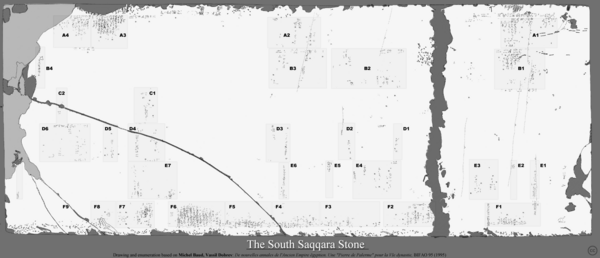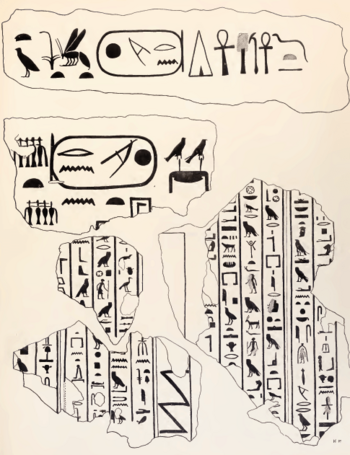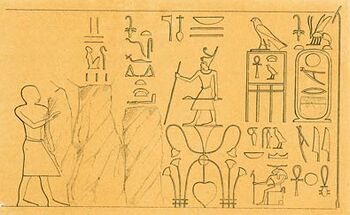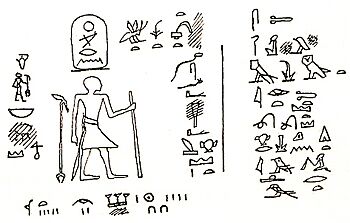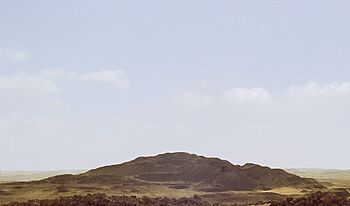Merenre Nemtyemsaf I facts for kids
Quick facts for kids Merenre Nemtyemsaf I |
|
|---|---|
|
|
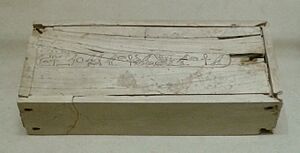
A small box of hippopotamus ivory inscribed with the royal titulary of Merenre Nemtyemsaf, Musée du Louvre
|
|
| Pharaoh | |
| Reign | 6–7 or 9–11 years in the early 23rd century BC. (Sixth Dynasty) |
| Coregency | uncertain, possibly with his father Pepi I, less likely with his successor Pepi II |
| Predecessor | Pepi I Meryre |
| Successor | Pepi II Neferkare |
| Consort | Ankhesenpepi II (aunt and stepmother) |
| Children | Ankhesenpepi III ♀ Iput II♀ Uncertain: Pepi II Neferkare ♂ |
| Father | Pepi I Meryre |
| Mother | Ankhesenpepi I |
| Burial | Pyramid of Merenre in Saqqara |
| Monuments |
|
Merenre Nemtyemsaf was an Ancient Egyptian pharaoh who ruled during the Sixth Dynasty. His name means "Beloved of Ra, Nemty is his protection". He was the fourth king of this dynasty. Merenre ruled Egypt for about six to 11 years. This was in the early 23rd century BC, towards the end of the Old Kingdom period.
Merenre was the son of Pepi I Meryre, the pharaoh before him. His mother was Queen Ankhesenpepi I. After Merenre, Pepi II Neferkare became pharaoh. Pepi II might have been Merenre's son or, less likely, his brother. Some historians think Merenre might have ruled alongside his father, Pepi I, for a short time. This is called a co-regency.
During Merenre's rule, there were big changes in how Egypt's southern provinces were managed. More local leaders were put in charge. At the same time, the central government in Memphis became smaller. This meant that local nobles became more powerful. They were responsible for collecting taxes and managing resources. This also led to important officials being buried in their home provinces, not just near the capital.
Merenre also sent many expeditions to trade and to get stone from quarries. He was especially interested in Nubia, south of Egypt. Caravans with hundreds of donkeys brought back valuable goods like incense, ebony, animal skins, ivory, and exotic animals. Merenre even had a canal dug to make it easier to sail past the first cataract into Nubia. Trade also happened with the Levant (modern-day Middle East) for things like lapis lazuli and silver.
A pyramid complex was built for Merenre in Saqqara. The Ancient Egyptians called it Khanefermerenre, meaning "The appearance of the perfection of Merenre". The inside walls of the pyramid's burial chambers were covered with Pyramid Texts. When explorers entered the burial chamber in the 1800s, they found the king's black basalt sarcophagus. A mummy was still inside, but its identity is not fully certain. After his death, people continued to honor Merenre with a special cult for a long time.
Royal Family
Parents and Siblings
Merenre's father was King Pepi I Meryre, and his mother was Queen Ankhesenpepi I. She was also known as Ankhesenmeryre. Pepi I was likely quite old when Merenre was born. Ankhesenpepi I's titles show she was the king's mother. She was the daughter of Khui, a local governor from Abydos. Her mother was Nebet.
Pepi I made Ankhesenpepi I a vizier. She was the only woman in the Old Kingdom period known to have held this important title. Merenre's uncle, Djau, who was Ankhesenpepi I's brother, also served as a vizier. He worked for both Merenre and Pepi II Neferkare.
Princess Neith was Merenre's full sister. Some historians think she might have married Merenre first, and then Pepi II. However, this is not completely certain.
Wives and Children
Records show that Merenre's aunt, Ankhesenpepi II, married Pepi I and then also married Merenre. She was the mother of the future pharaoh Pepi II. Her titles confirm this, calling her "royal wife of the pyramid of Merenre" and "royal mother of the pyramid of Neferkare [Pepi II]".
Many experts believe Pepi I was Pepi II's father. However, some historians think Merenre I was Pepi II's father. This is because Merenre ruled for about ten years, and Pepi II became king when he was only six years old. This timeline suggests Merenre was Pepi II's father.
Merenre had at least one daughter, Ankhesenpepi III. She later married Pepi II. Merenre might also have been the father of Queen Iput II, another wife of Pepi II.
Merenre's Rule
Evidence of His Reign
We know a lot about Merenre from archaeological finds. His name appears on many items, like an alabaster vessel and an ivory box in the Louvre Museum. There are also small sphinx statues in Scotland and Russia with his name. Other items include vases and a piece of tomb painting in the British Museum.
When He Ruled
Merenre Nemtyemsaf I's place in the Sixth Dynasty is clear. Historical records and archaeological evidence agree that he became king after Pepi I Meryre. He was then followed by Pepi II Neferkare. This makes him the fourth king of the dynasty.
Ancient lists of kings, like the Abydos King List and the Saqqara Tablet, confirm this order. The Turin Canon also seems to mention him. An ancient Egyptian historian named Manetho also wrote about Merenre. He called him Methusuphis and said he ruled for seven years.
It's hard to say exactly when Merenre ruled in our modern calendar. Experts use different methods to estimate dates, but there's always some uncertainty. Most agree Merenre ruled in the early 23rd century BC.
How Long He Ruled
Ancient Egyptians kept track of years by counting "cattle counts." These were events where livestock were counted to figure out taxes. During Merenre's time, these counts might have happened every two years. The latest record from his reign mentions the year after the 5th cattle count. If counts were every two years, this would mean he ruled for about ten years.
However, most modern historians believe Merenre ruled for less than a decade. Some suggest nine to eleven years, while others say six or seven years.
Merenre's father, Pepi I, may have faced some challenges during his rule. Some historians think Pepi I might have made Merenre king while he was still alive. This would have been to ensure a smooth transfer of power. This idea is called a co-regency, meaning two kings ruled at the same time.
One piece of evidence for a co-regency is a gold pendant with both Pepi I's and Merenre I's names. Another is a pair of copper statues found in Hierakonpolis. One statue is larger and represents Pepi I. The smaller, younger statue is thought to be Merenre. This could show that Merenre was publicly recognized as his father's successor.
However, the idea of a co-regency is not certain. Some experts say there's no clear proof. The ancient records don't directly mention a shared rule. The gold pendant and statues could have other meanings.
Activities in Egypt
Administration
Merenre's rule saw big changes in how Egypt was run. More local officials were put in charge of the provinces. They managed tax collection and local projects. This made the local areas and their leaders more important.
High-ranking officials, like viziers and governors, started to be buried in their home provinces. For example, the governor Harkhuf was buried in Qubbet el-Hawa near Aswan. This shows the growing power of the provinces.
Merenre also promoted important officials. Weni, a high-ranking official, was made leader of quarrying expeditions. He later became a vizier, one of the highest positions.
Religious Activities
Ancient records show Merenre made many offerings to different gods. He offered oxen to gods like Wadjet and Seth. A statue of the king might also have been built early in his reign.
Merenre also showed respect for earlier kings. He chose to build his pyramid complex close to that of Djedkare Isesi, a king from the Fifth Dynasty.
Building Projects
Merenre's main building project was his pyramid complex. There are also signs that he had work done at the temple of Osiris in Abydos. He might have built a special chapel there, similar to what his father did.
End of His Reign
Some historians have suggested a second co-regency, this time between Merenre and Pepi II. This idea comes from a seal that shows both kings' names. However, this is also uncertain. It could just mean the official served under both kings. Given that Pepi II was very young when he became king, many experts do not believe there was a co-regency between them.
Foreign Activities
Eastern Desert and Levant
Merenre sent at least one mining trip to Wadi Hammamat in the Eastern Desert. They went to get stone like greywacke for his pyramid. Weni, a high official, led this trip. He reported bringing back a sarcophagus and a pyramidion (the capstone for the pyramid).
Alabaster was also taken from Hatnub, another quarry in the Eastern Desert. Weni also led an expedition there to get a large stone altar for Merenre's pyramid.
Egypt likely traded with Byblos for cedar wood and with Canaan for other goods. An official named Iny might have led a sea trip to Syria-Palestine to get lapis lazuli, silver, and other metals.
Nubia
During Merenre's rule, Lower Nubia was very important to Egypt. Two rock carvings show Merenre receiving gifts from Nubian chiefs. One carving suggests it was made in his first year as king. Nubia was a source of valuable goods like incense, ebony, animal skins, and ivory.
Merenre sent three expeditions to Nubia to get luxury goods. These trips were led by Harkhuf, a caravan leader. He claimed to have brought peace to the lands south of Egypt. These expeditions were mainly for trade and gathering resources. They rarely involved fighting.
These trips were long, about 2000 to 3000 kilometers (1200 to 1800 miles) round-trip. They used large caravans of donkeys. Harkhuf's third trip had three hundred donkeys carrying goods like incense and grain.
In his fifth year of rule, Merenre traveled south to Elephantine. He went there to receive gifts from Nubian chiefs. An inscription near Philae shows him standing at the edge of foreign lands, with Nubian rulers bowing to him.
Weni, another important official, was also active in Nubia. He hired Nubian soldiers for military campaigns. Weni was also in charge of bringing large granite stones from Elephantine to Memphis for Merenre's pyramid. He used six cargo boats and three tow boats for this heavy task.
Merenre also ordered Weni to dig a canal near modern-day Shellal. This canal had five channels and ran next to the Nile. It was built to make it easier for boats to pass the First Cataract.
Merenre's Pyramid Complex
The pyramid of Merenre was built in South Saqqara. The Ancient Egyptians called it Khanefermerenre, meaning "Merenre appears in glory and is beautiful." It is located near the pyramids of Pepi I and Djedkare.
The pyramid was originally about 52.5 meters (172 feet) tall. Its base was about 79 meters (259 feet) long on each side. The inner passages of the pyramid were decorated with Pyramid Texts. These texts were meant to help the king in the afterlife. They include prayers, spells, and instructions for the king's journey to the sky.
Mortuary Temple
Merenre's pyramid was part of a larger complex. This included a mortuary temple where offerings were made to the king after his death. Parts of reliefs found there show gods greeting the king in the afterlife. Some of the temple's decoration was left unfinished, likely because the king died before it was completed.
The Mummy
In 1881, explorers entered Merenre's burial chamber through a robber's tunnel. They found the black basalt sarcophagus still there. Inside was the mummy of a man, about 1.66 meters (5 feet 5 inches) tall. The mummy was damaged by ancient tomb robbers.
The mummy was taken to Cairo, but it was further damaged during transport. Parts of it are now in the Egyptian Museum in Cairo and some bones were in the Egyptian Museum of Berlin.
Early studies of the mummy suggested it was a young man. However, the way it was wrapped seemed more typical of a much later period. This means the mummy might have been re-wrapped later, or it might not be Merenre's. Its identity is still uncertain.
Merenre's Legacy
Old Kingdom
Like other kings of his time, Merenre was honored with an official funerary cult. This cult took place in his pyramid complex. Local governors often oversaw the priests of these cults. For example, Qar, a governor of Edfu, was an "instructor of the priests of the pyramid 'Merenre appears and is beautiful'".
Some priests who served Merenre's cult are known by name. A papyrus letter from an inspector confirms that Merenre's pyramid town was active and successful during his reign and Pepi II's.
Later Periods
Later, in the Middle Kingdom period, some objects from Merenre's time were found in a special deposit. This suggests that some religious practices related to him continued.
Merenre was also honored in the New Kingdom period. His name appears on the Karnak King List, which was made to honor a selection of royal ancestors.
Merenre is also a character in the French animated cartoon series Papyrus. In the show, he is shown as a kind ruler and the father of Princess Théti-Chéri.



